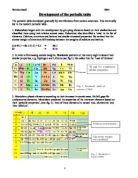John Newlands in 1863 noticed Dobereiner's table was written in order of ascending atomic weight and every eighth element had similar properties. He called this The Law of Octaves. However, after the first 20 elements, he had to put two elements into the same position for it to make sense. Also some of the atomic weights of the elements had been imprecisely measured. He was set on the right tracks but he wasn't quite there yet. Six years after this attempt, Mendeleev had created his renowned periodic table.
As mentioned earlier Mendeleev had left gaps in his table, so that the undiscovered elements would be found and they would fit in perfectly. Fortunately for Mendeleev, Paul Lecoq de Booisbaudran discovered an unknown substance when he was examining zinc sulfide ore, using spectroscopy. When looking at its spectrum, he noticed a faint violet line that wasn't usually present in the known spectrum of zinc sulfide. He carried investigations by trying to collect more of this new substance and find out its properties. This was the discovery of a new element named Gallium When the news got to Mendeleev he was thrilled as this was one of the missing elements he had identified on his table in Group 3 below Aluminum. His properties matched up to Boisbaudran 's and this gave Mendeleev's table great publicity. However, his prediction of the density of Gallium was different to Boisbaudran's. He had asked him to double-check its density as Mendeleev's prediction was 6.0g cm-3 and Boisbaudran's was 4.9g cm-3. Then Boisbaudran found that the actual density of Gallium was 5.93g cm-3, which closely matched Mendeleev's initial prediction!
Gallium is an unusual element. It has different properties that can suggest it's both a metal and a non-metal, although it's classed as a metal. Its chemical properties that would suggest it’s a metal are:
-
Its low melting point of 29.78oC so in slightly hotter countries than the UK it would be a liquid metal at room temperature
Many Scientists have tried to explain why Gallium has such a low melting point but the only explanation that they can come up with is that it could be due to their being Ga2 molecules in the liquid.
- Its range from boiling point to melting point is the largest of any liquid, due to its high boiling point and its low melting point. So that’s why it is most commonly used as a liquid in thermometers
- It has dative covalent bonds when it is in the anhydrous trichloride form
- It dissolves in acids and alkalis like the element before it, Aluminum, while also producing Hydrogen
Gallium's chemical properties that would suggest it's a non-metal are:
- It resembles with water in the sense that it is denser as a liquid than solid at freezing point. This is probably because the solid form has more of an open structure than the liquid form.
Gallium is an element that occurs naturally, like the other 92 elements in the periodic table. However, the number of elements has increased due to Scientists manufacturing elements beyond Uranium. They have started to 'synthesise elements artificially'. The first element to be made in this was neptunium. Increasingly more Scientists began to find elements like this and by 1965 a whole number of elements from 94 to 102 were found. As more were found, it became harder to create elements beyond those found. It became a competition as to who could find the next element first.
The UNILAC accelerator was brought in to be used to fire beams of metal ions into metal targets, to get the nuclei to fuse together so a new element could be formed. More radioactive elements were produced, but once they formed they'd decay in 20 seconds. This effort put into finding these elements has led to rows over who discovered them and who should name them.
Element number 114 is the most wanted element yet to be formed. It's down to it being amazingly stable and its ability to last for years unlike afew seconds. The Quantum theory suggests that the nucleus has separate shells for protons and neutrons. Each shell can only hold a certain number of protons and neutrons (magic numbers): 2, 8, 20, 28, 50, 82, 126. If the nucleus has each of its shells filled to all of these numbers it's a stable element against radioactive decay. Lead, element 82 is very stable as it has this magic number of protons and its isotope 126, also has this magic number of neutrons, making it even more stable. So element 114 should be very stable because Scientists have predicted that there are higher magic numbers, also its isotope 184 would be twice as magic.
994 words
Summary: Main Chemical Points
Mendeleev created the periodic table in 1869. He left gaps and predicted the properties of undiscovered elements. When they were found they matched his predictions and his table was accepted. Elements today are being artificially formed that don't exist naturally by using a UNILAC accelerator that go beyond Mendeleev's table.
50 words







